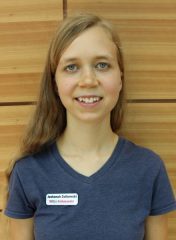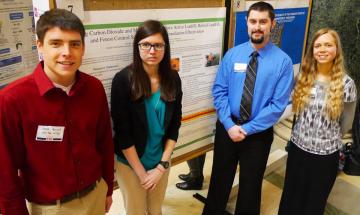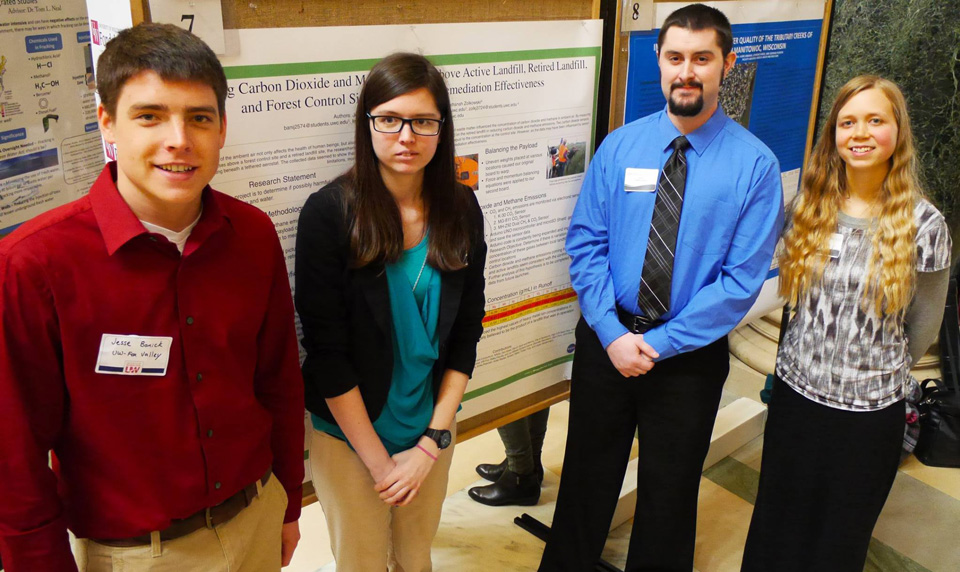 University of Wisconsin Oshkosh chemistry and mathematics senior Jeshanah Zolkowski, of Neenah, will present two projects—one related to each of her majors—at the 17th-Annual UW System Symposium for Undergraduate Research, Scholarly and Creative Activity Friday, April 20.
University of Wisconsin Oshkosh chemistry and mathematics senior Jeshanah Zolkowski, of Neenah, will present two projects—one related to each of her majors—at the 17th-Annual UW System Symposium for Undergraduate Research, Scholarly and Creative Activity Friday, April 20.
Zolkowski is one of five UW Oshkosh students to present at the event, held this year at UW-Green Bay.
The symposium offers students from across the UW System the opportunity to share their research projects on a wide variety of topics through research poster presentations, oral presentations, gallery exhibits and artistic performances.
A good start at UW-Fox Valley
Zolkowski said her educational journey began at UW-Fox Valley, “where some wonderful mentors” encouraged her to pursue a career in academia.
 She co-led a student-driven, research effort called the Tethered Aerostat Program, which was sponsored and funded by the Wisconsin Space Grant Consortium.
She co-led a student-driven, research effort called the Tethered Aerostat Program, which was sponsored and funded by the Wisconsin Space Grant Consortium.
“It was in this program that I learned how to create my own opportunities and step into them,” she said. “In my final year at UW-Fox Valley, I presented two research projects, and it seemed fitting that I do the same at UW Oshkosh.”
Continuing to grow at UW Oshkosh
For her senior year at UW Oshkosh, Zolkowski worked with faculty mentors Christopher Bianchetti and Stephen Szydlik, on her projects, “Producing Tactile Protein Models for Chemistry Education,” and “Applying the Mathematics of DNA Topology to Circular RNA Molecules,” respectively.
“These projects have taught me more about the rewards and challenges of research,” Zolkowski said. “Motivation is vital to any self-guided project. If you self-initiate and have a good mentor, you can teach yourself almost anything.”
However, this doesn’t mean there won’t be hiccups along the way.
“You must creatively overcome obstacles, she explained. “In chemistry this may mean using different materials, while in math it may be working to understand an unexpected pattern.”
That motivation and ability to problem-solve have impressed Szydlik. “Jeshanah is at or near the top of the best mathematics students that I have encountered in my 20-plus years of teaching at UWO,” he said.
In her mathematics research, Zolkowski is using knot theory to study the topology (or the mathematical structure) of the DNA molecule.
“She does a wonderful job of exposition–making hard ideas clear, as she explains different aspects of her project,” Szydlik said “During a given meeting, I might make some suggestions about some things to work on. But for the most part, she is self-directed, motivated, and incredibly focused.”
Szydlik said that Zolkowski recently gave a presentation about her project at the annual meeting of the Mathematical Association of America’s Wisconsin Section in Eau Claire.
In presenting her research, Zolkowski said she has learned how to adapt abstracts and speeches to appeal to the target audience.
“She impressed both the experts and the non-experts in the room, and made me really proud,” he said, adding that her skills will serve her will if she chooses to pursue a doctorate in mathematics in the future.
“My ideal situation would involve teaching calculus and studying how my favorite enzyme relates to my favorite area of math,” she said.
 In addition to Zolkowski, the following UW Oshkosh science students will present their research at the symposium Friday:
In addition to Zolkowski, the following UW Oshkosh science students will present their research at the symposium Friday:
- Zachary Chambers, a junior chemistry major from New London, paired with faculty mentor Jennifer Schuttlefield Christus (chemistry) on “Kinetics of Formation of Struvite from Wastewater.”
- Konrad Fondrie, a senior biology major from Appleton; and Samantha Schroeder, a senior microbiology major from Peshtigo, worked with faculty mentor Sabrina Mueller-Spitz (biology) on “Characterization of Biomass Degrading Bacillus and Paenibacillus Species from a Wet Fermentation Digester.”
- Nathan Witman, a senior from Lily majoring in biology, biomolecular science and Spanish,worked with faculty mentor Lauren Waters (Chemistry) on “Determining the Function of a Small Protein Involved in the Mn Regulation of Manganese Homeostasis in E. coli.”
Learn more:

